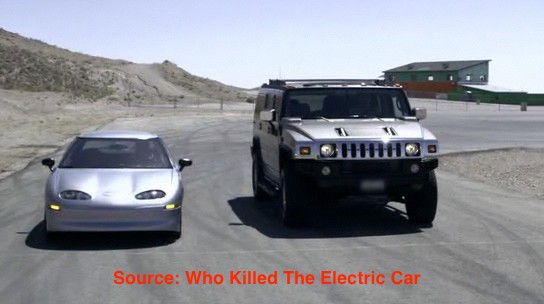Last weekends news that GM plans to resurrect the Hummer caused my jaw to hit the floor – “Oh no, GM is killing the electric car AGAIN“. But reading on, learning that GM does NOT plan to resurrect the Hummer Of Old, the gas guzzling behemoth that it was, but plans its resurrection as a Brand New Hummer. Namely, a Hummer-branded electric pickup truck that will be available starting in 2022.
Right on GM, that’s what we want to see. GM surely can do a better electric pickup truck than Tesla’s Cybertruck, since GM has a much more complete understanding of the needs of truck buyers. Plus, between GM, Ford, Tesla, Rivian and some others, we’re beginning to see some serious competition in electrifying a very important segment of the automotive market – pickup trucks.
Unfortunately we don’t know much about GM’s plan for an electric Hummer. We’re told that a campaign will launch in February 2020, with a celebretyitis tie-in with some guy who plays basketball.
Instead I want to go over some history and explain why this is a big deal.
The birth of the Hummer

Back in 1992 AM General, a manufacturer of military vehicles, began selling a retail version of the Humvee to the civilian market. The Humvee is a military vehicle. Arnold Schwarzenegger in the 1980’s began a campaign to launch a civilian version after watching a convoy of Humvee’s while filming The Kindergarten Cop. Schwarzenegger bought the first two Hummer H1’s.
In December 1999, AM General sold the Hummer brand to General Motors with AM General continuing to be the manufacturer. Shortly afterward GM introduced the Hummer H2 and H3, its own design built by GM.
Backlash against the Hummer
In 2004 I happened to attend the San Francisco Auto Show, not because I wanted to see the latest and greatest in engines. In fact I was randomly chosen by a TV news crew to be interviewed about what I was looking for, so I gave them a spiel about the dangers of climate change and peak oil, that I was there looking for an electric car, and was disgusted by all the engines. The interviewer was professional about it, let me speak my piece without interruption, and I have no idea whether that got on the air. But I do remember the cameraman nodding with understanding.
I was there because ZAP – one of the early electric vehicle entrepreneurs that fortunately went out of business years ago – was there showing some vehicles. Specifically ZAP had a plan to import Smart Fortwo’s, converting them for the American market. They even had this advertisement:

In case you can’t see it, the car in the middle has a California license plate with the word Electric. Unfortunately ZAP’s Smart was still gasoline powered, their electric cars were underpowered NEV’s, and in general ZAP was a flaky company that deservedly died a few years later. The point of bringing in this advert is to demonstrate that, in some circles, there was a backlash against Hummers.
After visiting with ZAP’s booth, while wandering the exhibition hall getting a deeper understanding of the depth of interest some people have in engines, I heard in the distance some chanting like a protest rally. Walking over that way I found members of Code Pink and Raging Grannies circled around the Hummer exhibit, and some had climbed on top of one of the Hummers. The whole group was chanting Hybrids not Hummers and other slogans.

How do Hummer’s fuel wars? Simply because the USA is nowhere near able to supply enough crude oil to make enough gasoline to supply its own needs for fuel. The Hummer of that era was an example of an extremely wasteful gasoline guzzling behemoth – 10-15 MPG, and a gross vehicle weight way beyond other SUV’s. The Hummer is a symptom of a mindset that we can use as much gasoline as we want, and that there’s no dangerous side effects.
One of the actual side effects of that mindset, the wars in the Middle East, are largely about feeding America’s addiction to oil and natural gas. Those wars have caused massive pain and suffering for 20 years or so, and the deaths of hundreds of thousands of people.
The Fracking Boom that began in the late 2000’s caused a big upsurge in crude oil production in the USA – at the cost of continued dependence on fossil fuels, and a continued worsening of air quality and climate change. Despite increased oil production the USA is still not able to supply its own oil needs. Therefore the USA powers-that-be see it necessary to continue invading and controlling countries that have oil supplies.
In 2004, when Code Pink and Raging Grannies staged that protest, the Iraq War was still in its early stages. ISIS hadn’t been formed yet, Syria hadn’t been invaded yet, and on and on. But it was obvious at that time the 2003 invasion of Iraq was all about controlling oil supplies in the Middle East.
The Hummer was seen by many as the poster child for the problems with the USA automotive industry in the 2000’s. Collectively the car companies were ignoring the need for high fuel efficiency, and instead selling the world on gas guzzling SUV’s.
Hummer killed the GM EV1 – according to Who Killed The Electric Car

The documentary Who Killed The Electric Car contains a commentary that GM wanted to get on with selling highly profitable SUV’s, and therefore pressured the California Air Resources Board to modify the ZEV mandate. It wasn’t just GM, but the other car companies put similar pressure on CARB. Coincidentally when CARB finally relented and changed the ZEV mandate, within days the car companies announced the ending of their electric car programs, and famously the EV1 and other cars were crushed.
The ZEV Mandate grew out of California’s efforts to combat air pollution. It required that the car companies make a certain percentage of sales in California as electric vehicles, in order to continue having the right to sell cars in California at all.
In any case the Hummer’s role in WKtEC demonstrates how emblematic the Hummer was to many.
GM’s Bankruptcy and the Hummer
To many of us GM’s bankruptcy in 2008 was symbolized again by the Hummer and the focus on gas-guzzling SUV’s. The reason, many said at the time, that USA automakers ran into such problems is because they were selling vehicles we did not want.
Yes this bankruptcy occurred in the middle of a broader economic crisis, that has been blamed on the financial industry having gone overboard selling mortgages to people with questionable credit. But there’s another side to this story that’s more directly relevant to the car industry.
In 2007-8 the price for oil and gasoline rose precipitously high. In part this was because of tensions in the Middle East, because the continuing war threatened oil supplies. But also oil production in the USA had fallen to all-time lows, causing an increasingly high dependence on foreign oil.
During 2007-8 the high gasoline prices became one of the talking points of the Presidential election. How would the incoming President solve the problem of high oil prices? Supposedly in Texas guys had parked their Ford F-150’s and were buying fuel efficient cars by Honda or Toyota.
A more practical effect was an announcement in June 2008![]() that GM would close four of its truck and SUV plants, expand production of fuel efficient cars, and move forward with developing an electric vehicle. The Washington Post article had GM CEO Wagoner claiming that “four dollar a gallon gasoline” had changed consumer behavior. Further, since high oil prices was a “structural change” rather than a “cyclical change”, and that there is a “long-term trend towards higher energy costs”, GM must therefore change direction. As for the Hummer, GM was to undertake a review of that brand, and seek to sell it to another company or else shut down the brand.
that GM would close four of its truck and SUV plants, expand production of fuel efficient cars, and move forward with developing an electric vehicle. The Washington Post article had GM CEO Wagoner claiming that “four dollar a gallon gasoline” had changed consumer behavior. Further, since high oil prices was a “structural change” rather than a “cyclical change”, and that there is a “long-term trend towards higher energy costs”, GM must therefore change direction. As for the Hummer, GM was to undertake a review of that brand, and seek to sell it to another company or else shut down the brand.
Of course the financial crisis of late 2008 made everyone forget the high oil price worries, because the economy almost went into another Great Depression. Even worse, when GM did introduce the Chevy Volt, a chorus of naysayers blamed it on Pres. Obama forcing GM to make an electric car, when in fact GM had planned on the Volt long before Obama came to office.
GM killed the Hummer in 2010

In June 2009, as part of GM’s bankruptcy announcement, the company announced it would close down the Hummer brand and stop producing Hummers. That was closely followed by an announcement that a Chinese company had bought out the brand. But by February 2010 that deal had fallen through.
Hummer’s electric rebirth
In June 2019, Bloomberg News![]() reported on a rumor that GM is considering reviving the Hummer as an electric truck. The idea of an electric Hummer comes in the context of GM CEO Mary Barra claiming GM has an “all-electric future”. At that time an electric Hummer was positioned as a “What If” idea as GM pondered which models it would built using the electric truck battery pack it has developed.
reported on a rumor that GM is considering reviving the Hummer as an electric truck. The idea of an electric Hummer comes in the context of GM CEO Mary Barra claiming GM has an “all-electric future”. At that time an electric Hummer was positioned as a “What If” idea as GM pondered which models it would built using the electric truck battery pack it has developed.
Bloomberg says GM has “two major batter-electric vehicle programs”.
The first is called the BEV3 project, under which the company is developing a line of passenger cars, crossover SUV’s and a variety of other small and mid-sized models. The company has pledged to put 20 EV’s on the road globally by 2023. The second program would manufacture electric pickups, and other full-size vehicles, some of which are destined for off-road applications.
For better or for worse, GM builds many large-sized vehicles all of which have a place in the market. To electrify every kind of vehicle means developing suitable drive trains and battery packs.
At the time Bloomberg News thought an electric Hummer would be years away. The electric truck project is well underway, but those models aren’t predicted until after the debut of BEV3 vehicles.
Earlier in 2019 GM and Rivian had been in talks to form a joint venture outside Detroit. That deal fell apart, however, and GM then accelerated development of its own electric pickup and SUV program.
Then on January 10, 2020, the Wall Street Journal![]() broke news that GM indeed was launching an electric Hummer.
broke news that GM indeed was launching an electric Hummer.
The new Hummer would not be a stand-alone brand, but instead one vehicle in the GMC line. This will help GM avoid the cost of building out a Hummer-specific dealer network. Further, production of the Hummer is expected to begin in early 2022 as an electric truck, and a Hummer SUV in 2023.
Looks to me that GM’s move symbolizes the shift underway in the automotive industry. The Hummer of Old represented the worst excesses of the age of gasoline. The Hummer of New may well represent what can be accomplished with electric drive trains.
- Is there enough Grid Capacity for Hydrogen Fuel Cell or Battery Electric cars? - April 23, 2023
- Is Tesla finagling to grab federal NEVI dollars for Supercharger network? - November 15, 2022
- Tesla announces the North American Charging Standard charging connector - November 11, 2022
- Lightning Motorcycles adopts Silicon battery, 5 minute charge time gives 135 miles range - November 9, 2022
- Tesla Autopilot under US Dept of Transportation scrutiny - June 13, 2022
- Spectacular CNG bus fire misrepresented as EV bus fire - April 21, 2022
- Moldova, Ukraine, Georgia, Russia, and the European Energy Crisis - December 21, 2021
- Li-Bridge leading the USA across lithium battery chasm - October 29, 2021
- USA increasing domestic lithium battery research and manufacturing - October 28, 2021
- Electrify America building USA/Canada-wide EV charging network - October 27, 2021



















Pingback: Big advertising splash for GMC Hummer EV – The Long Tail Pipe